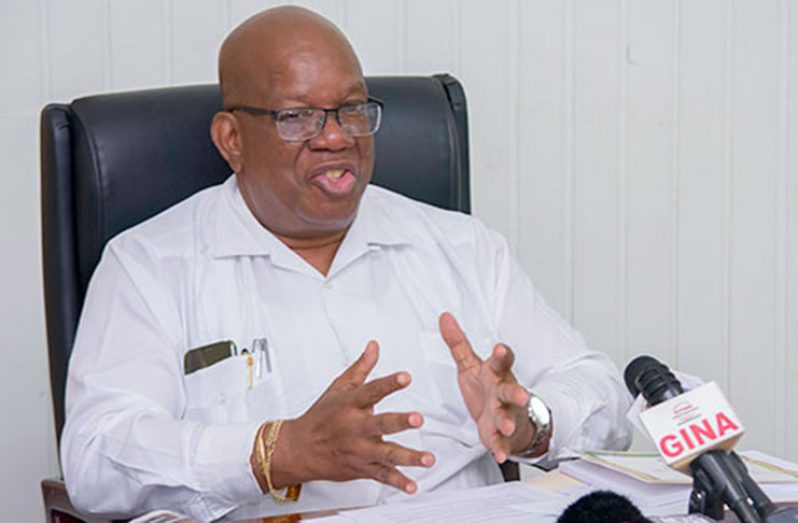REBASING Guyana’s Gross Domestic Product (GDP) is among plans the Finance Ministry hopes to accomplish in 2018, Finance Minister Winston Jordan has said.
Rebasing would reduce the influence of the sugar industry on the growth of the country’s economy.
Currently, the country’s GDP is compiled relative to the base year 2006. The Guyana Bureau of Statistics (GBS) explains that a country compiles its GDP at current and constant prices by industry, mainly by the production method.
GDP by expenditure is compiled residually for the economy as a whole, and at current prices only.
In a recent interview, Minister Jordan said the sugar industry had been a “major downfall” for the country in 2017, negatively influencing the country’s economic growth. Last year, the country fell short in achieving its projected growth rate of 3.8 per cent.
Instead, it recorded a real growth rate of 2.9 per cent. The performance of the ailing sugar industry was in part responsible for the decline, but the Finance Ministry hopes to reduce its influence on the economy this year.
“Of course, the major downfall this year [2017] has been sugar, it will continue to be a downfall, but one thing that we are looking forward to next year is the rebasing of the GDP,” Minister Jordan explained.
“This rebasing will see the lowering of the influence of sugar in our growth rate,” he added, noting that with sugar projected to do a mere 115,000 tonnes, its overall influence in the economy has dropped considerably.
He further explained that as a result of the GDP and the series that is in use, the sugar industry still has a major influence on the growth of the economy and “in a sense it drags down the growth.”
“Hopefully with the rebasing, we can see a truer picture of the performance of the economy,” Minister Jordan posited.
According to the Bureau of Statistics, the rebasing and revising of the national accounts, which was conducted during 2007 to 2009, allowed not only the adoption of a more recent base year (previously 1988), but facilitated the use of more modern measurement techniques and a truer picture of economic structure.
It was further explained that in the rebased and revised series, the increasing contribution of services to the economy and the subsequent diminishing contribution of traditional industries are evident. Data is collected on the output of the real and services industries of the economy.
REASONABLE
Nonetheless, when reflecting on 2017, the finance minister said Guyana’s economic performance was “reasonable” when compared to its immediate neighbours.
“Yes, we did fall short of the anticipated 3.8 per cent we had, but I think the important thing here is that the glass is half full and not half empty. We did record 2.9 per cent,” he posited.
This year, it is projected that the economy will grow at 3.8 per cent.
“If everything goes well, we expect not only to achieve that growth, but possibly surpass it,” said an optimistic Jordan.
This year, improved performances are expected from the forestry and agriculture sectors with manganese coming on stream.
“If everything comes on stream we expect to be on target. I would love to see it hit the four per cent mark, but it all again depends on what happens to sugar,” Minister Jordan said.
Among the measures unveiled in the 2018 Budget is the restriction on importation of pine wood and pine wood products.
At the recent meeting of the Council for Trade and Economic Development (COTED), an organ of CARICOM, Guyana’s request for a suspension to increase the Common External Tariff (CET) on pine wood and pine wood products from five per cent to 40 per cent, was approved. The new tariff took effect from January 1, 2018 and will expire on December 31, 2019.
Exemption of logs and rough-sawn lumber from VAT with effect from January 1 was approved in the 2018 Budget.
Minister Jordan said under the previous administration, the forestry sector was dominated by foreign companies on the basis that they had received “unlimited” concessions. In addition to offering these concessions, the finance minister said the previous administration “did nothing to support local forestry.”
As such, he said the measures included in the 2018 Budget seek to correct the wrongs committed to that sector.
It is believed that the measures will improve the cash flow of forest sector operators, including smaller producers, by at least $80 million. The forestry board also made note of the setting aside of $120 million to commence a national forest inventory. Also, $50M has been budgeted to allow government to partner with the private sector in a Public/Private Partnership, to establish a Dimension Stockyard.



.jpg)








